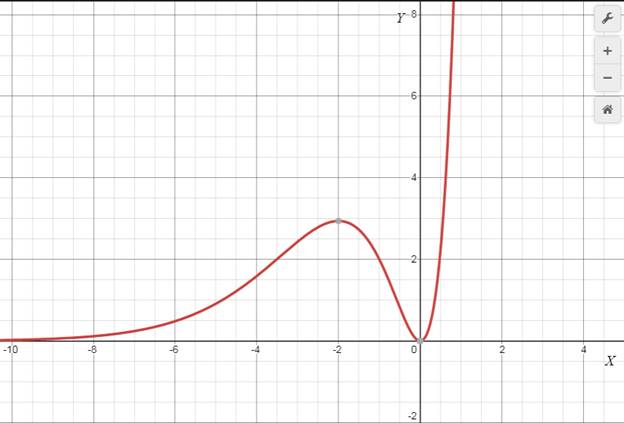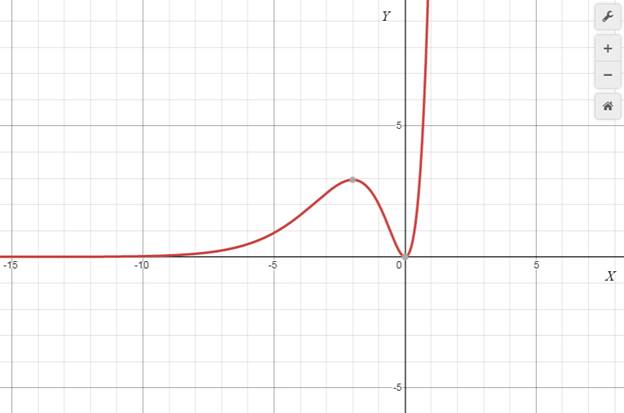
Concept explainers
a.
Draw the graph of the function .
a.
Explanation of Solution
Given: It is given in the question that the function is
Graph:

Interpretation: The graph for the function
In the graphic utility,simply put the function on that and the graph will get it.
Conclusion:
b.
Find the interval on which the function is increasing and decreasing.
b.
Answer to Problem 58E
The increasing and decreasing intervals for the fumction are
Explanation of Solution
Given:
It is given in the question that the function is
Concept Used:
In this,use the concept of understanding the graph and know to find the point of intersection.
Calculation:
As ,it is find that the graph is given below:

As,it is seen in the curve the two coordinates are found
So,
The interval of the increasing is
The interval of the decreasing is
Conclusion:
The increasing and decreasing intervals are
c.
Find the approximate
c.
Answer to Problem 58E
The Maximum
Explanation of Solution
Given:
It is given in the question that the function is
Concept Used:
In this,use the concept of finding the maxima and
Calculation: The function is
Differentiate the function,
Now,the interval that is found in the above part is
Conclusion:
The Maximum
Chapter 3 Solutions
PRECALCULUS W/LIMITS:GRAPH.APPROACH(HS)
- Find the accumulated amount A, if the principal P is invested at an interest rate of r per year for t years. (Round your answer to the nearest cent.) P = $3800, r = 4%, t = 10, compounded semiannually A = $ 5645.60 × Need Help? Read It SUBMIT ANSWER [3.33/6.66 Points] DETAILS MY NOTES REVIOUS ANSWERS ASK YOUR TEACHER TANAPCALC10 5.3.001.EP. PRACTICE ANOTHER Consider the following where the principal P is invested at an interest rate of r per year for t years. P = $3,100, r = 4%, t = 10, compounded semiannually Determine m, the number of conversion periods per year. 2 Find the accumulated amount A (in dollars). (Round your answer to the nearest cent.) A = $ 4604.44arrow_forwardForce with 800 N and 400 N are acting on a machine part at 30° and 60°, respectively with a positive x axis, Draw the diagram representing this situationarrow_forwardI forgot to mention to you to solve question 1 and 2. Can you solve it using all data that given in the pict i given and can you teach me about that.arrow_forward
 Calculus: Early TranscendentalsCalculusISBN:9781285741550Author:James StewartPublisher:Cengage Learning
Calculus: Early TranscendentalsCalculusISBN:9781285741550Author:James StewartPublisher:Cengage Learning Thomas' Calculus (14th Edition)CalculusISBN:9780134438986Author:Joel R. Hass, Christopher E. Heil, Maurice D. WeirPublisher:PEARSON
Thomas' Calculus (14th Edition)CalculusISBN:9780134438986Author:Joel R. Hass, Christopher E. Heil, Maurice D. WeirPublisher:PEARSON Calculus: Early Transcendentals (3rd Edition)CalculusISBN:9780134763644Author:William L. Briggs, Lyle Cochran, Bernard Gillett, Eric SchulzPublisher:PEARSON
Calculus: Early Transcendentals (3rd Edition)CalculusISBN:9780134763644Author:William L. Briggs, Lyle Cochran, Bernard Gillett, Eric SchulzPublisher:PEARSON Calculus: Early TranscendentalsCalculusISBN:9781319050740Author:Jon Rogawski, Colin Adams, Robert FranzosaPublisher:W. H. Freeman
Calculus: Early TranscendentalsCalculusISBN:9781319050740Author:Jon Rogawski, Colin Adams, Robert FranzosaPublisher:W. H. Freeman
 Calculus: Early Transcendental FunctionsCalculusISBN:9781337552516Author:Ron Larson, Bruce H. EdwardsPublisher:Cengage Learning
Calculus: Early Transcendental FunctionsCalculusISBN:9781337552516Author:Ron Larson, Bruce H. EdwardsPublisher:Cengage Learning





